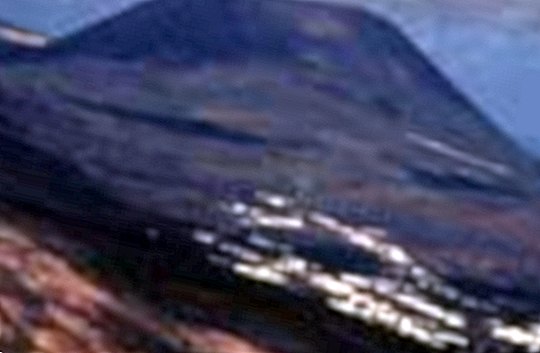Lanzarote

The ferry stops at Playa Blanca, the place in southern Lanzarote. On the right is the bright Papagayo beach, where lavas, which flowed into the sea centuries ago, have divided into bays. Finally, on the port side, a colorful harbor with bars and restaurants behind which white holiday bungalows have conquered the hillside - Playa Blanca!
Wild game of color contrasts
The road to the north. On the right Yaiza appears, a village on the edge of hell. And Yaiza shines! The snow-white houses shine with their bottle-green window frames; green date palms and dragon trees, and the red hibiscus flames. It is this wild play of contrasts that makes up Lanzarote's character.
Lanzarote has hardly any groundwater. And rain falls as seldom as on Fuerteventura. But this island has wine, lots of wine. Already Shakespeare's Falstaff took possession of Lanzarote's heavy Malvasia. Because the Lanzaroteños had discovered early that the Picón helps them to grow. Picón they call the fine-grained lava, which was distributed in the volcanic eruptions far across the island. The dew condenses on the porous stones and seeps into the soil. So the campesinos dug holes in the asphalt layer until they found fertile ground. They put the plants in each of them - each in its own funnel.
The sunset gilds the city
Teguise, the oldest city in the Canary Islands, is just a few kilometers away. Silence. A few tourists only, a few old men in front of a bar. The white of the houses and the churches reflects the afternoon sun and blinds the eyes. The city is built entirely in Andalusian style, unlike Arrecife, the capital, otherwise as Haría in the north. Teguise could also be in Mexico or southern California.
The next day I meet Mario Perdomo in Arrecife. The 38-year-old journalist is a member of the board of "El Guincho", the most important cultural and environmental organization in Lanzarote. One of its founders more than ten years ago was the painter and sculptor César Manrique, who shaped the face of the island like no other.
The island as a Gesamtkunstwerk
It was Manrique's idea to turn this island of contrasts into a total work of art through human intervention. He created the lookout point on the strait between Lanzarote and La Graciosa, influenced the island architecture, built restaurants and hotels in a style appropriate to the grandiose landscape; and at every important intersection are his wind chimes. The largest near the village of Tahiche, where Manrique was killed in a traffic accident in 1992. César Manrique was the unwanted father of that mass tourism who devoured the land in Puerto del Carmen, Playa Blanca and Costa Teguise.
In the footsteps of the volcano
The hell of Timanfaya: From 1730 on, the volcanoes roared in Lanzarote for 6 years, burying 14 villages and an area of 200 square kilometers under their magma. On a dead straight road I drive through black, violent, hostile country. One still thinks to feel the heat and the fire, which broke over the people at that time. In front of me the Montañas del Fuego, the mountains of fire. They shine in every imaginable red and yellow tones. They are the colors of death and destruction.
The sun is burning and the storm stifles every word in this landscape. At the viewpoint Islote de Hilario, where Manrique built the restaurant "El Diablo", I change to a bus. Slowly he drives through hollow paths of solidified slag to the crater rim of Timanfaya. Music by Beethoven and the finale of Richard Strauss' "Zarathustra" - a background for a bizarre color play of nature, for a beautiful tragedy.
travel service
residential: Hotel "Meliá Salinas", luxury hotel, designed for the César Manrique the jungle-like courtyard and the beautiful pool landscape. Two first class restaurants. It is considered one of the best hostels in Spain.
to eat and drink
"El Amanecer", c / Garita in Arrieta, Tel. 0034-28-83 54 84: Canarian cuisine, fish specialties.
"La Canada", c / Cesar Manrique 3, Puerto del Carmen, tel. 0034-28-51 21 08: upscale style, freshly caught fish, lamb and rabbit dishes.
"El Moreno", c / Quintero 24 in San Bartolomé, Tel. 0034-28-52 03 87: rustic and local, large portions, especially spit slices, crabs in garlic.
"El Bar del Club" in the marina of Puerto Calero, nice view, great service, Fridays barbecue with live music. "LagOmar" in Oasis de Nazaret, below the Casa Omar Sharif, Tel. 0034-28-84 56 65: fantastic complex with crater lake and waterfall, first-class cuisine.
holiday reading
the novel "Océano" by Alberto Vázquez-Figueroa, set in the late forties, is the first part of a trilogy about the fate of the Lanzaroteñan fisherman family Perdomo (Goldman Paperback).










